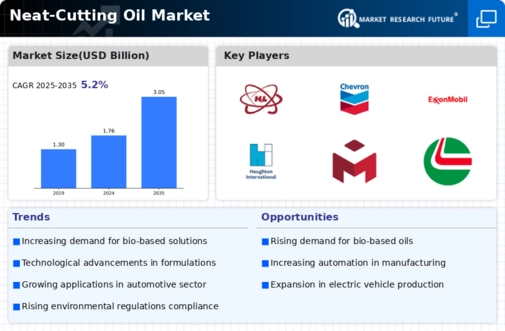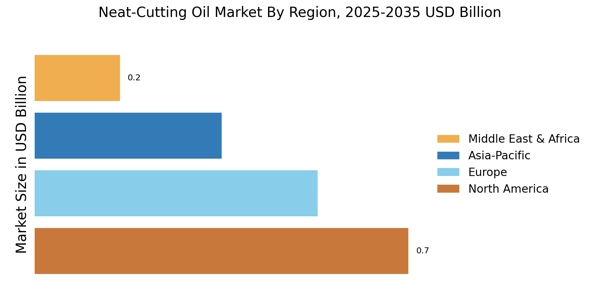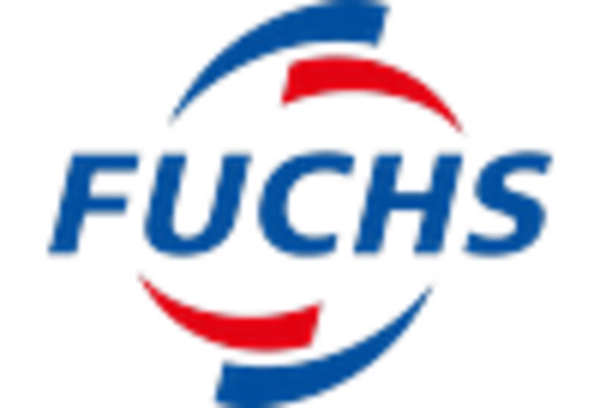Global Trade Dynamics
The dynamics of global trade are significantly impacting the Neat-Cutting Oil Market. As countries engage in international trade, the demand for cutting oils is influenced by factors such as tariffs, trade agreements, and supply chain logistics. In 2025, it is expected that trade policies will continue to shape the market landscape, with emerging economies increasing their manufacturing capabilities and, consequently, their consumption of neat-cutting oils. This trend may lead to a more competitive market environment, as manufacturers adapt to varying regulations and standards across different regions. The interplay of global trade dynamics is likely to create both challenges and opportunities for stakeholders within the Neat-Cutting Oil Market.
Expansion of Automotive Industry
The expansion of the automotive industry is a pivotal driver for the Neat-Cutting Oil Market. As automotive production ramps up, the demand for high-quality cutting fluids to support the machining of engine components and other critical parts is expected to rise. In 2025, the automotive sector is projected to account for a substantial share of the neat-cutting oil consumption, with estimates indicating a growth rate of around 5% in this segment. This growth is fueled by the increasing complexity of vehicle designs and the need for precision machining. Consequently, manufacturers are likely to seek advanced neat-cutting oils that can meet the stringent requirements of modern automotive applications, thereby bolstering the Neat-Cutting Oil Market.
Increased Focus on Sustainability
The Neat-Cutting Oil Market is increasingly influenced by a growing focus on sustainability and environmental regulations. As industries strive to reduce their carbon footprint, there is a rising demand for eco-friendly cutting fluids. In 2025, it is anticipated that the market for bio-based neat-cutting oils will expand significantly, driven by both regulatory pressures and consumer preferences for sustainable products. This shift is likely to encourage manufacturers to invest in research and development of biodegradable and non-toxic formulations. The emphasis on sustainability not only aligns with global environmental goals but also presents opportunities for companies within the Neat-Cutting Oil Market to differentiate their products and enhance their market position.
Rising Demand in Manufacturing Sector
The Neat-Cutting Oil Market is experiencing a notable increase in demand driven by the expanding manufacturing sector. As industries such as automotive, aerospace, and machinery continue to grow, the need for efficient metalworking fluids becomes paramount. In 2025, the manufacturing sector is projected to contribute significantly to the overall demand for neat-cutting oils, with estimates suggesting a growth rate of approximately 4.5% annually. This growth is largely attributed to the rising production of precision-engineered components, which require high-performance cutting fluids to enhance machining efficiency and tool life. Consequently, manufacturers are increasingly investing in advanced neat-cutting oils that offer superior lubrication and cooling properties, thereby propelling the Neat-Cutting Oil Market forward.
Technological Innovations in Formulations
Technological advancements in the formulation of neat-cutting oils are playing a crucial role in shaping the Neat-Cutting Oil Market. Innovations such as the development of high-performance synthetic and bio-based oils are gaining traction due to their enhanced properties, including improved lubricity and reduced environmental impact. In 2025, the market is likely to witness a surge in the adoption of these advanced formulations, as they offer better performance in extreme conditions and longer service life. Furthermore, the integration of nanotechnology in oil formulations is expected to enhance the efficiency of neat-cutting oils, making them more appealing to manufacturers. This trend indicates a shift towards more sustainable and efficient solutions within the Neat-Cutting Oil Market.


















Leave a Comment